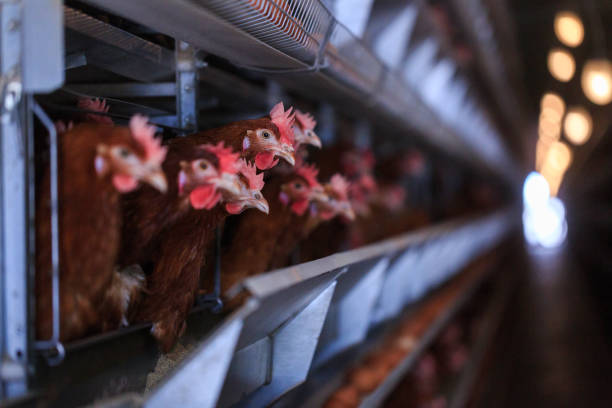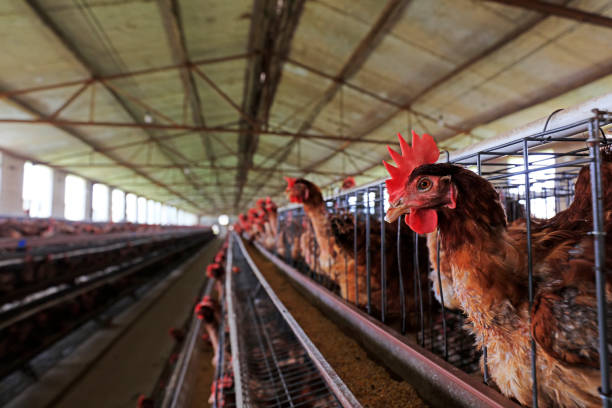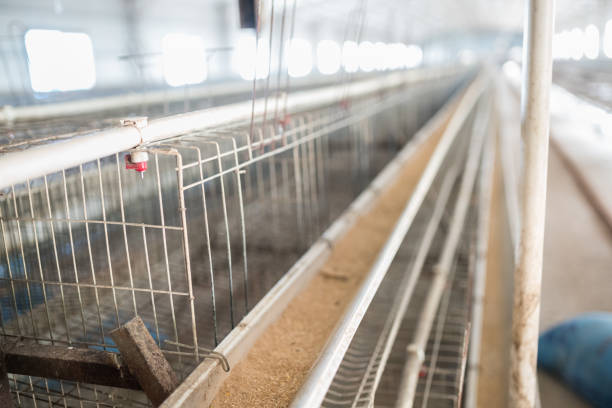
Investing in a 70,000 Broiler Chicken Cage System: A Guide for African Farmers
Investing in a 70,000 Broiler Chicken Cage System: A Guide for African Farmers
For African farmers looking to scale up their broiler production, investing in a large-scale broiler chicken cage system like a 70,000-bird facility can seem like a daunting but potentially highly rewarding venture. This guide provides a comprehensive overview of what to consider before taking the plunge, covering everything from the benefits and initial investment to operational considerations and long-term sustainability.
Why Choose a Cage System for Broiler Farming?
Before delving into the specifics of a 70,000-bird operation, it’s crucial to understand why cage systems are gaining popularity in broiler farming in Africa. Traditionally, broilers were raised in deep litter systems, but cage systems offer several advantages:
Improved Hygiene: Cages elevate the birds above their waste, reducing the risk of disease outbreaks and improving overall hygiene. This leads to healthier birds and reduced mortality rates.
Higher Stocking Density: Cages allow for a higher stocking density per square meter compared to litter systems. This means you can raise more birds in the same amount of space, maximizing your investment.
Easier Management: Cage systems simplify tasks like feeding, watering, and waste removal. This reduces labor costs and allows for more efficient management of the flock.
Better Feed Conversion Ratio (FCR): Birds in cages have less freedom to move around, which translates to lower energy expenditure. This leads to a better FCR, meaning they convert feed into meat more efficiently.
Reduced Broiler Breast Blisters: The well-designed cages will minimize the occurrence of broiler breast blisters.
Improved Air Quality: Cage systems, especially when combined with proper ventilation, help to improve air quality in the broiler house, reducing respiratory problems.
Is 70,000 Birds the Right Scale for You?
While a 70,000-bird operation offers substantial potential, it’s essential to assess whether it aligns with your resources and market access. Consider the following:
Market Demand: Can you consistently sell 70,000 broilers every 6-8 weeks (typical grow-out period)? Research local and regional market demand to ensure you have a reliable outlet for your product. Is there already a well-established broiler industry in your area? If so, will you be able to compete?
Financial Resources: A 70,000-bird cage system requires significant investment. Do you have access to sufficient capital or financing options?
Management Expertise: Managing a large-scale operation requires strong management skills. Do you have experience in broiler farming or access to qualified personnel?
Infrastructure: Do you have access to reliable utilities like electricity and water? Are the roads adequate for transporting feed, chicks, and processed birds?
Biosecurity: Can you implement strict biosecurity measures to prevent disease outbreaks?

If you’re unsure, starting with a smaller-scale operation might be a wiser approach to gain experience and test the market before committing to a larger investment.
Components of a 70,000 Broiler Chicken Cage System:
A complete broiler chicken cage system comprises several key components:
Cage Structure: This includes the cages themselves, typically made of galvanized steel wire mesh, arranged in tiers. Consider the type of cage design: A-frame cages or H-frame cages. H-frame cages are usually more automated and require a higher initial investment. Ensure the cage design allows for adequate ventilation, easy access to feed and water, and efficient waste removal. Cage dimensions vary but should provide sufficient space per bird according to welfare standards.
Feeding System: Automatic feeding systems are essential for a large-scale operation. These systems typically consist of feed hoppers, augers or chain feeders, and feed troughs that distribute feed evenly to all cages. Choose a system that is reliable, easy to maintain, and minimizes feed wastage.
Watering System: Nipple drinkers are commonly used in cage systems. They provide a continuous supply of clean water to the birds, minimizing spillage and contamination. Ensure the system provides adequate water pressure and flow rates.
Waste Removal System: Efficient waste removal is crucial for hygiene and odor control. Options include manual scraping, belt manure removal systems, or automatic scraper systems. Automatic systems are more expensive but significantly reduce labor costs.
Ventilation System: Proper ventilation is essential for maintaining optimal air quality and temperature inside the broiler house. Options include natural ventilation (using strategically placed openings) or mechanical ventilation (using fans). Mechanical ventilation is more reliable, especially in hot and humid climates. Consider tunnel ventilation for larger houses.
Climate Control System: In regions with extreme temperatures, a climate control system may be necessary to maintain optimal growing conditions. This could include cooling pads, heaters, and temperature sensors.
Lighting System: Proper lighting is essential for broiler growth and development. LED lights are energy-efficient and can be programmed to mimic natural daylight cycles.
Control System: A centralized control system can automate and monitor various aspects of the operation, such as feeding, watering, ventilation, and temperature. This allows for more precise control and improved efficiency.
Cost Breakdown and Investment Considerations:
The initial investment for a 70,000-bird broiler chicken cage system can be substantial. Here’s a general breakdown of the costs involved:
Cage System: This is typically the largest expense, accounting for 40-50% of the total investment. Prices vary depending on the type of cage, automation level, and supplier.
Building Construction: Constructing a broiler house to accommodate the cage system is another major expense. Consider the size, materials, and design of the building. You’ll need proper insulation, flooring, and drainage.
Feeding and Watering Systems: The cost of these systems depends on the level of automation and the quality of the equipment.
Waste Removal System: Automatic waste removal systems are more expensive than manual systems.
Ventilation and Climate Control Systems: The cost of these systems depends on the climate and the desired level of control.
Lighting System: LED lighting is more expensive upfront but will save money on electricity in the long run.
Control System: A centralized control system can add to the initial cost but will improve efficiency and reduce labor costs.
Land: The cost of land will vary depending on the location and size of the property.
Other Costs: Include costs for permits, licenses, consulting fees, and initial stock of chicks and feed.
It’s crucial to obtain detailed quotes from multiple suppliers and develop a comprehensive budget before making any commitments. Be sure to factor in potential cost overruns and contingency funds.
Operational Considerations:
Once the system is in place, efficient operation is crucial for profitability:
Chick Sourcing: Source high-quality chicks from reputable hatcheries to ensure good growth rates and disease resistance.
Feed Management: Provide a balanced and nutritious diet that meets the specific needs of broilers at different stages of growth. Work with a nutritionist to optimize feed formulations.
Water Management: Ensure a continuous supply of clean, fresh water. Monitor water consumption to detect any potential problems.
Health Management: Implement a strict biosecurity program to prevent disease outbreaks. Vaccinate birds against common diseases and monitor them closely for any signs of illness. Consult with a veterinarian regularly.
Waste Management: Dispose of waste properly to prevent environmental pollution and odor problems. Consider composting or other methods of waste treatment.
Mortality Management: Dispose of dead birds promptly and hygienically. Implement measures to reduce mortality rates.
Labor Management: Hire and train competent staff to manage the operation efficiently. Provide them with clear instructions and adequate supervision.
Energy Management: Implement energy-saving measures to reduce electricity costs. Consider using renewable energy sources like solar power.

Record Keeping: Maintain accurate records of feed consumption, mortality rates, growth rates, and other key performance indicators. This data will help you identify areas for improvement.
Choosing the Right Supplier:
Selecting a reliable supplier is critical for the success of your broiler chicken cage system. Consider the following factors:
Experience and Reputation: Choose a supplier with a proven track record in providing high-quality equipment and services. Ask for references from other farmers.
Product Quality: Ensure the cages and other equipment are made of durable materials and meet industry standards.
Technical Support: Choose a supplier that provides good technical support and after-sales service.
Warranty: Check the warranty terms and conditions before making a purchase.
Price: Compare prices from multiple suppliers, but don’t base your decision solely on price. Consider the overall value and quality of the product.
Local Presence: A supplier with a local presence can provide faster and more efficient support.
Customization: Can the supplier customize the system to meet your specific needs?
Sustainability Considerations:
Sustainability is becoming increasingly important in broiler farming. Consider the following:
Environmental Impact: Minimize the environmental impact of your operation by implementing sustainable practices such as composting waste, reducing water consumption, and using renewable energy sources.
Animal Welfare: Ensure the welfare of your birds by providing them with adequate space, ventilation, and access to feed and water.
Economic Viability: Ensure the long-term economic viability of your operation by managing costs effectively and maximizing productivity.
Community Engagement: Engage with the local community and address any concerns they may have about your operation.
Financing Options:
Securing financing can be a major challenge for African farmers. Explore the following options:
Commercial Banks: Banks may offer loans for agricultural projects, but they typically require collateral and a strong business plan.
Microfinance Institutions: Microfinance institutions may offer smaller loans to farmers with limited access to traditional banking services.
Government Programs: Many African governments have programs to support agricultural development. These programs may offer subsidies, grants, or low-interest loans.
Development Organizations: International development organizations may provide funding or technical assistance to agricultural projects.
Private Investors: Consider seeking investment from private investors who are interested in supporting sustainable agriculture.
Investing in a 70,000-bird broiler chicken cage system can be a profitable venture for African farmers, but it requires careful planning, significant investment, and strong management skills. By considering the factors outlined in this guide, you can increase your chances of success and contribute to the growth of the broiler industry in Africa. Remember to thoroughly research market demand, secure adequate financing, choose a reliable supplier, and implement sustainable practices. With careful planning and execution, a 70,000-bird broiler operation can be a rewarding and sustainable investment. Good luck!

